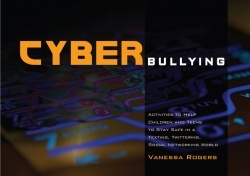Cyberbullying
Teens and children text, network, twitter, and tweet in ever-growing numbers. Increasingly, they share their activities, feelings, and pictures with numerous “friends” on social networking Web sites. But also increasing are problems arising from digital communications, including cyberbullying, whereby the technology is misused to threaten, harass, humiliate, or embarrass.
Cyberbullying helps parents and professionals who work with young people develop guidelines to educate them about the safe use of the Internet and what to do when they feel uneasy or threatened.
Vanessa Rogers, a teacher and youth work consultant in England, gives real-life examples of cyberbullying and offers activities that professionals and parents can do with groups of young people or individuals to educate them about online behavior. The book is divided into three sections: “Warm-Ups,” “Activities,” and “Reviews.” All use interactive exercises to teach children and teens about the many facets of cyberbullying and what they can do to avoid being a victim or participant in this destructive phenomenon.
While some cyberbullying is intentional—an unflattering picture posted on Facebook, a hurtful rumor passed along in a chat room, an unkind comment about a classmate on a social networking site—other unintentional but thoughtless remarks or jokes can quickly turn into a rapidly circulated source of pain for someone. This book gives many examples that teach young people about their responsibility when using the Internet and provides tools to help young people avoid being the bully or the bullied.
“Young people can utilize a vast range of digital communication tools to share experiences and keep in touch in a way that way that previous generations could only imagine,” Rogers writes. “However, there is a darker side to this shiny new digital world which cannot be ignored.”
Rogers is the author of several other resource books for adults who work with young people, including Work with Young Women and Work with Young Men, also from Jessica Kingsley Publishers. Cyberbullying helps to head off dangerous encounters online and is suitable for parents of children and teens and adults working with young people in youth clubs or school. A good reference book for a public, school, or home library, it is written in easy-to-understand language, with helpful examples of situations that can arise and positive, safe ways to deal with them.
Reviewed by
Penny Hastings
Disclosure: This article is not an endorsement, but a review. The publisher of this book provided free copies of the book and paid a small fee to have their book reviewed by a professional reviewer. Foreword Reviews and Clarion Reviews make no guarantee that the publisher will receive a positive review. Foreword Magazine, Inc. is disclosing this in accordance with the Federal Trade Commission’s 16 CFR, Part 255.

